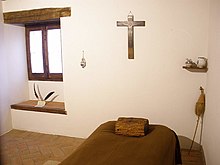
Back صومعة (عمارة) Arabic Хөжрә Bashkir Келля Byelorussian Килия Bulgarian سەومەعە CKB Klášterní cela Czech Klosterzelle German Κελί (μοναστικό) Greek Celda (convento) Spanish Kelja Finnish

A cell is a small room used by a hermit, monk, nun or anchorite to live and as a devotional space. Cells are often part of larger cenobitic monastic communities such as Catholic, Lutheran, Anglican and Orthodox Christian monasteries, as well as Buddhist vihara,[1] but may also form stand-alone structures in remote locations. The word cell comes from the Old French celle meaning a monastic cell, itself from the Latin meaning "room",[2] "store room" or "chamber".[3]
Usually, a cell is small and contains a minimum of furnishings. It may be an individual living space in a building or a hermit's primitive solitary living space, possibly a cave or hut in a remote location. A small dependent or daughter house of a major monastery, sometimes housing just one or two monks or nuns, may also be termed a cell.
The first cells were in the Nitrian Desert in Egypt following the ministry of Paul of Thebes,[4] Serapion, and Anthony the Great.[5] in the mid 3rd century.
In some orders, such as the Trappists, the monks or nuns do not have cells but sleep in a large room called a dormitory. In eremitic orders like the Carthusians, the room called cell usually has the size and look of a small house with a separate garden.
- ^ Cell at Merriam Websters Dictionary.com.
- ^ Cell at dictionary.reference.com.
- ^ cell at Oxford Dictionaries.
- ^ St Pauls Monastery Egypt.
- ^ Chryssavgis, John; Ware, Kallistos; Ward, Benedicta, In the Heart of the Desert: Revised Edition The Spirituality of the Desert Fathers and Mothers (World Wisdom Bloomington, Ind., 2008) p15.